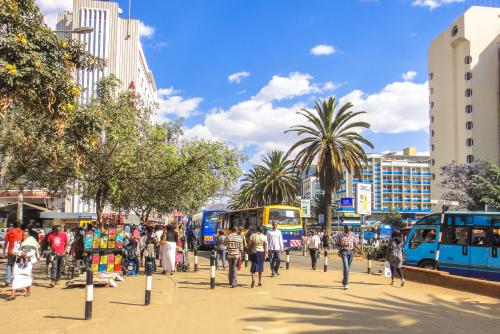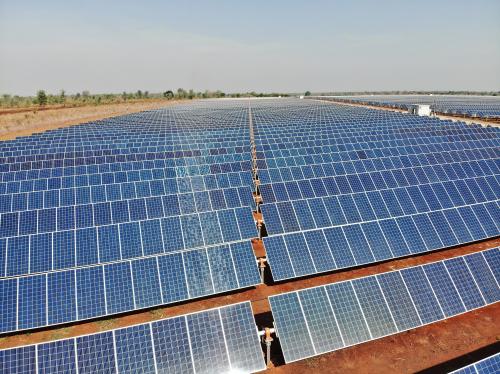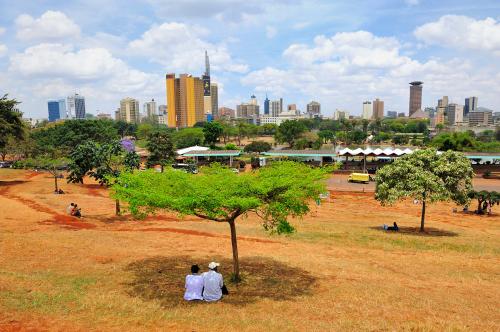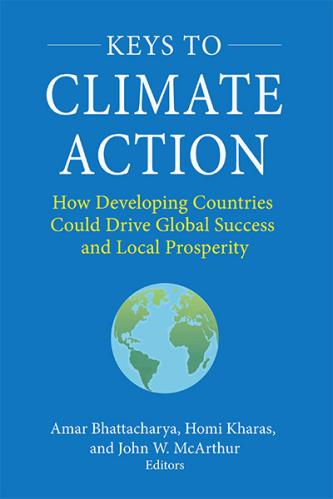Below is a viewpoint from the Foresight Africa 2023 report, which explores top priorities for the region in the coming year. Read the full chapter on climate change.
Sub-Saharan African countries (SSA) face twin challenges that are slowing growth and eroding decades of developmental gains: Rising debt levels and an increasing frequency and severity of climate shocks. The compounding nature of these challenges has left countries with deteriorated public finances, poor resilience to climate shocks, and limited capacity to finance adaptation. Of the 38 sub-Saharan African countries covered in the debt sustainability analyses conducted through the joint World Bank-International Monetary Fund Debt Sustainability Framework for Low-Income Countries (LIC-DSF), seven are already in debt distress, 18 are at high risk, and 13 are at moderate risk. The second challenge is high climate risk exposure. The Notre Dame Global Adaptation Index, or ND-Gain, assesses a country’s susceptibility to the effects of climate changes like sea-level rise, disease, and drought, as well as its readiness to improve resilience and adapt to them. Currently, the average ND-Gain score for 183 countries globally is 49 (out of 100). But when looking at the performance of 47 SSA countries, only three achieved scores at or above the global average–Cabo Verde, Mauritius, and Seychelles.
Climate vulnerability is deepening SSA’s debt challenges. Recent evidence from the IMF shows that when controlling for conventional determinants of sovereign defaults, countries with higher climate vulnerability have an increased probability of defaulting, compared to more resilient countries.
Climate vulnerability is deepening SSA’s debt challenges. Recent evidence from the IMF shows that when controlling for conventional determinants of sovereign defaults, countries with higher climate vulnerability have an increased probability of defaulting, compared to more resilient countries. Of the 20 SSA countries with the highest levels of climate vulnerability in the ND-Gain Index, 30 percent are already in debt distress, and another 35 percent are at high risk. There are three primary channels through which climate change is adversely affecting public finance and driving up debt.
- The first is via increased expenditure and borrowing required to respond to climatic shocks. In 2019, Cyclones Idai and Kenneth drove Mozambique’s public debt to almost 110 percent of GDP, and the IMF gave the country a $118 million interest-free loan.
- The second is slowed economic growth and a decline in domestic revenue. This is due to a myriad of factors including business and supply chain disruptions, productivity losses, and property damage.
- Third, exposure to climate shocks can lead to a repricing of sovereign assets, which reduces creditworthiness and drives up borrowing costs. In 2020, Fitch (credit rating agency) announced that water risks (such as water scarcity or extreme water events, such as droughts and floods) will likely become a more significant sovereign rating driver over the medium- to long-term, against the backdrop of severe climate change. Fitch further noted that African countries are especially exposed to flood risks, particularly Benin, Rwanda, and Mozambique. Countries where droughts or floods have been explicitly mentioned as hinderances to growth, external finances, and/or inflation in the context of a downgrade include Namibia (June 2020) and Zambia (April 2020).
But how do African policymakers manage these compounding crises? Here are three recommendations:
- Strengthen financial planning for disasters: Governments can adopt financial instruments to reduce the need for costly emergency borrowing and time-consuming budget reallocations. This can include contingency funds that are earmarked for disaster response, sovereign insurance that delivers payouts in the event of severe crises, and catastrophe bonds for pre-arranged, cheaper lending in the event of a shock. Such instruments can provide rapid disbursements to finance critical needs such as food security, public health, and shelter when a shock occurs.
- Improve efficiency of expenditures: Medium-term fiscal planning should prioritize investments in climate resilient infrastructure to reduce future recovery and reconstruction costs, in the event of a climate-related shock.
- Closely monitor implicit and explicit contingent liabilities: Climate-related contingent liabilities are obligations that only materialize when a shock occurs. The magnitude of these liabilities, which include sovereign guarantees, additional social security spending, relief expenditures, public health costs, extraordinary critical infrastructure replacement, and firm bailouts, often remains unknown, making them one of the biggest fiscal risks across African countries. Monitoring these liabilities enables countries to be more financially prepared and have less fiscal volatility.
Given the interconnected nature of the climate and debt crises, prioritizing the development of financial and physical resilience to climate change, is key to supporting long-term debt sustainability.








Commentary
Managing the compounding debt and climate crises
March 1, 2023